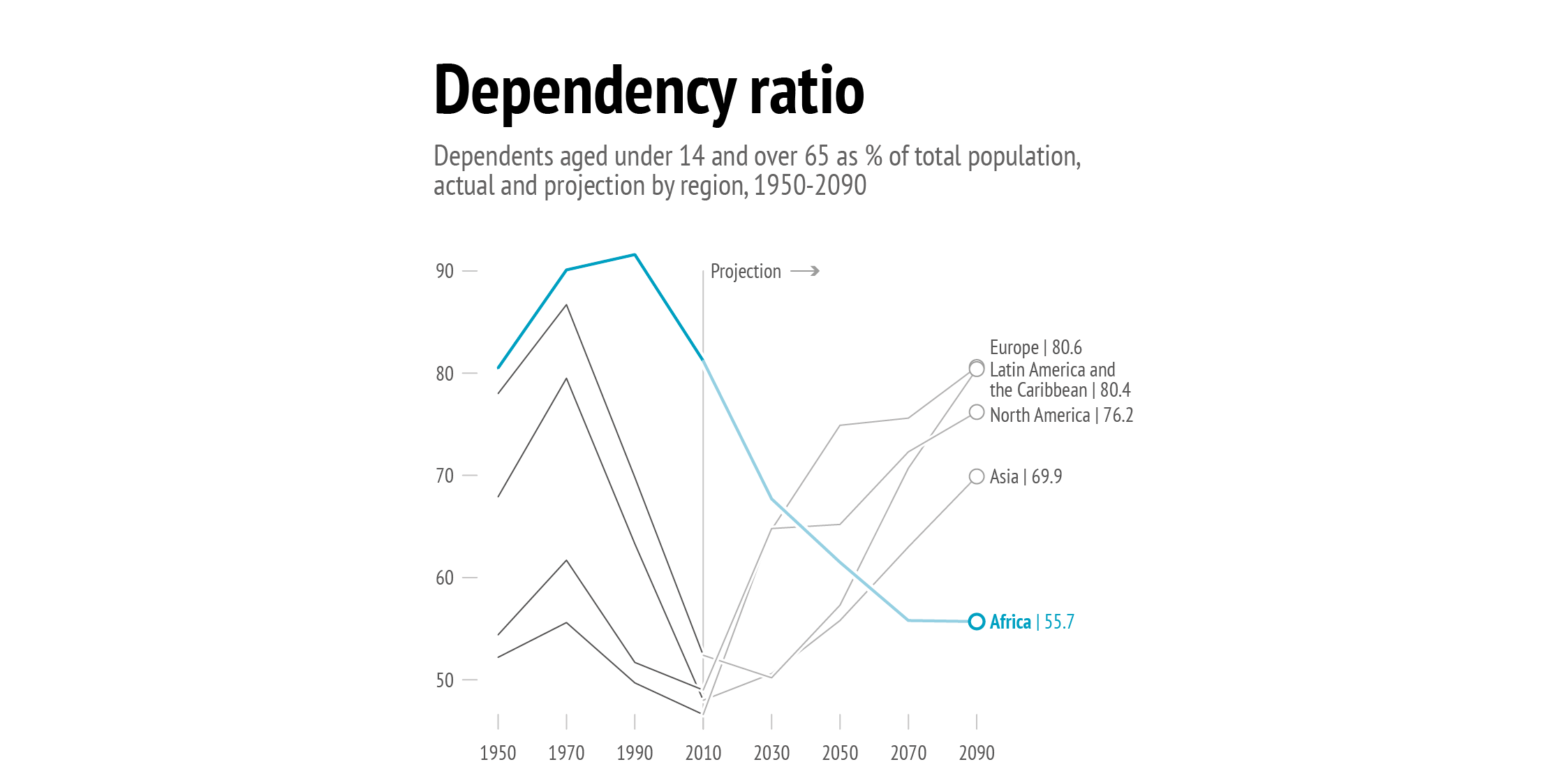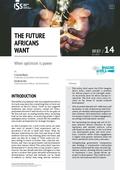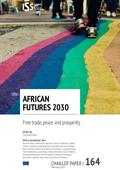You are here

Reaping Africa’s demographic dividend
Introduction
Although African countries have achieved reasonable economic growth of over 4 % per annum in the past two decades, many of them have failed to transform (1) their economies and substantially improve the living standards of the people. Lack of or limited progress in economic transformation has left many African countries vulnerable to external shocks such as commodity price volatility and most recently the Covid-19 pandemic.
Pre-Covid, the continent was already experiencing a slowdown in growth and poverty reduction overall, although with large variations among countries. For example, over the period 2015–2019 average gross domestic product (GDP) growth ranged from 1.2 % (Nigeria) to 8.9 % (Ethiopia), while the poverty headcount ratio at USD 1.90 per day ranged from 27.3 % (The Gambia) to 85.8 % (Democratic Republic of the Congo) (2). Africa’s growth has not created enough productive employment opportunities for the growing workforce. And the Covid-19 pandemic has exacerbated the employment challenges. The World Bank has estimated that the pandemic may have pushed 34 million people in sub-Saharan Africa (SSA) into extreme poverty in 2021 (3). While the outlook appears grim, the pandemic has afforded an opportunity to scan the future horizon and explore how Africa could ‘build back better’.
This second Brief in the Imagine Africa series analyses Africa’s biggest resource: its youth (4). Declining mortality, high and slowly declining fertility, and the youthful age structure are driving Africa’s rapid population growth (5). Africa’s working-age population (aged between 15–64) was estimated to be 750 million in 2019 and is forecast to exceed 1 billion before 2030 and to reach 1.1 billion by 2035 (6), with young Africans (aged between 15–24) entering the labour force at a rate of about 20 million each year (7). The boom in Africa’s young population could result in either a demographic dividend or a demographic time-bomb (8). The Brief explores both of these scenarios. Based on trends in fertility, education, job creation, climate risks and economic growth, a business-as-usual scenario argues that Africa will miss the demographic dividend in 2030, if current trends continue. A more optimistic scenario shows instead how the dividend can be achieved as a result of effective policy actions to address the frontline issues of population growth, education and climate risks.
Scenario 1: Africa misses out on the demographic dividend in 2030
It is 2030 and the demographic transition is still progressing slowly in Africa due to a slow decline in fertility, which remains high in comparison to other regions of the world. Africa’s Total Fertility Rate (TFR) has remained virtually the same as a decade earlier (4.2 children per woman of reproductive age in 2021, 4.0 in 2030), almost twice the global average of about 2.4 births, with large variations across and within countries (9), and is projected to only reach around 3.0 in 2050 (10). Most African countries have not reached the TFR threshold of 2.8 or lower required to trigger the demographic dividend before the turn of the century, which has hampered faster economic growth and economic transformation (11).
Although Africa’s share of the working age population has been rising since 1987, the dependency ratio (the ratio of those not in the labour force to working age workers) has not been falling fast enough. In 2030 it is still much higher than the average for Latin America and Asia (see diagram). This slower pace of decline in the dependency ratio has been due to the slower rate of fertility decline in Africa relative to these regions which achieved their demographic transition around 2010. While a declining dependency ratio points to a potential demographic dividend, the size of the dividend depends on how fast the dependency ratio falls. In Africa’s case, the ratio peaked at a very high point, but is falling slowly which implies that the prospects for a continental-wide dividend could be limited.
Past economic growth in Africa has not been fast and inclusive enough to provide decent employment opportunities for the ever-increasing population of young people. On the basis of the pre-Covid average GDP growth rate of around 5 % per annum, Africa was set to miss the Sustainable Development Goal (SDG) 1 of eliminating extreme poverty by 2030. And indeed, 35 % of the population of SSA is still living in extreme poverty as of January 2030 (12). By 2035, about 20 million formal jobs would need to be created each year compared to an average of 3 million formal jobs being currently created per year (13). Only 40 % of the workforce is engaged in productive employment, with about 70 % in vulnerable employment (14), while the unemployment rate average is about 8 % (15). Agriculture continues to account for the largest share (around two-thirds) of total employment, especially in the low- and middle-income countries. The sectoral composition of employment is still virtually the same as it was in 2015, with agriculture still dominating the share of total employment. The expected shift to more jobs in manufacturing has failed to occur.
African youth face serious unemployment challenges. Nearly 16 million young people, around 12.4 % of the total labour force of 15 to 24-year-olds, were unemployed in 2019 (16). This was more than twice the unemployment rate of those aged over 25+ (6.1 %) (17).
The youth employment challenge is being exacerbated by the ongoing Fourth Industrial Revolution (4IR) which increasingly demands digital and science, technology, engineering and mathematics (STEM) skills that are in short supply. Employment prospects over the medium term will remain bleak due to the poor growth outlook. Due to the Covid-19 pandemic and the slow vaccine rollout in 2021–2022, the region returned to pre-crisis growth levels in 2024 as predicted by the International Monetary Fund (IMF) (18) and growth is currently around 4 %. But the economy should have been growing by at least 6.8 % annually in order to be able to absorb the 20 million workers entering the workforce each year (19).
In 2030, the persistent unemployment problem continues to drive more young people to migrate to wealthier countries in Europe and the US. Inadequate government efforts to address climate change have led to an increase in the frequency of droughts, floods and storms. Higher temperatures in 2030 have reduced Africa’s crop yields by more than 20 % (20). Failure to address the climate risk has also led to a rapid decline in natural resources such as freshwater resources and some 35 million Africans are now living in water stressed areas (21). The climate and unemployment challenges have contributed to a rise in violence and political instability in the region as predicted by various studies a decade ago (22).
Scenario 2: an inclusive and more prosperous Africa in 2030
In 2030, Africa has achieved the demographic dividend. Economic growth has more than doubled from a decade ago. This has been done by reforming the education curricula to respond to the evolving labour market, creating productive employment opportunities, taking measures to accelerate the demographic transition, building climate resilience among farmers, exploiting Africa’s abundant renewable energy resources to increase energy access, and by deepening regional integration and collaborating to promote regional public goods.
Education and skills training have been scaled up by expanding secondary and tertiary enrolments, with emphasis on STEM and technical and vocational education and training (TVET) focusing on new technologies, especially digital technologies of the 4IR. The gender bias in STEM and TVET has been eliminated by using innovative mechanisms such as awareness campaigns, performance-based contracts and cash and in-kind transfers targeting girls to increase their enrolment and attendance, and improve their academic performance. Education systems and TVET programmes have been overhauled and scaled up across the continent to respond closely to the needs of the market by partnering with the private sector for programme design and financing. The large informal sector is formalised through digital innovations, establishing learning and apprenticeship programmes that co-opt informal learning systems in partnership with NGOs and private agencies, leading to certification of the participants.
Opportunities for productive employment for young people are being created by diversifying the economy from reliance on raw commodity exports to modernised agriculture and high value-added manufacturing and services. Agriculture has been climate-proofed through increased spending on agricultural R&D which has enabled appropriate climate-smart agriculture technologies to be scaled up. This has led to a 50 percentage-point increase in productivity compared to 2020 levels (23). Value-chain activities such as storage, logistics and input services have been upgraded and the workforce has been successfully reskilled for 4IR jobs. This has resulted in around 20 million new jobs being created annually across the continent compared to 3 million in 2020 (24).
By the end of the 2020s, the African Union’s Programme for Infrastructure Development in Africa (25) has been fast-tracked to vastly reduce Africa’s infrastructure gap in electricity, telecommunications, roads, and railways. Through concerted regional collaboration, power generation from renewable energy sources has been progressively scaled up to achieve 100 % energy accessibility (26). Regional collaboration has also improved cross-border labour mobility to facilitate the free movement of skilled labour to areas of demand within the African Continental Free Trade Area (AfCFTA), leading to increased job creation.
Investments in education and health as well as enhanced employment opportunities have helped to accelerate the demographic transition. In particular, the TFR has been reduced from 4.2 children per mother in 2021 to 2.0 in 2030 through programmes to enhance women’s empowerment. These include investments made to improve educational quality and close the gender gap in secondary and tertiary education enrolments. Other measures taken include expansion of immunisation programmes and other communicable disease prevention programmes, improvement in health data systems, and boosting the quality of clinical care. Around 90 % of countries in the region have adopted legislation to recognise girls’ and women’s rights as citizens and give them greater autonomy in decision-making (27).
Successfully tackling the frontline challenges of providing productive employment opportunities and managing climate risks has been possible because African countries have deepened regional integration, namely through the AfCFTA, and collaborated to provide regional public goods such as transport corridors and well-managed river basins. Furthermore, this has been achieved as a result of committed leadership promoting citizen engagement at all levels including the political class, the public sector, private sector, academic, media and civil society.
Conclusion
Africa’s growing demographic bulge of young workers offers an opportunity for the continent to reap a demographic dividend that can lead to faster economic growth and improved prosperity. This will, however, not occur automatically.
The foregoing analysis suggests that Africa could miss out on the dividend entirely or at best make only a modest gain. This can be attributed to several reasons including the fact that fertility rates across the continent remain stubbornly high despite improvements over the past three decades. Past economic growth has not been sufficiently rapid and inclusive to create decent jobs for the fast-growing workforce. On the negative side, the growing youth unemployment problem could be a catalyst for violence and political instability, as we are already witnessing in some West African countries.
This scenario can, however, be reversed with the aid of policies to scale up education and skills training to prepare the workforce for 4IR jobs. To reap the demographic dividend, African governments should accelerate the fertility transition by implementing programmes to close the gender gap in education and economic opportunities, and by instituting laws and institutional reforms to recognise women’s rights and grant them greater autonomy in decision-making. International development partners (e.g. the EU, United Kingdom, United States) can assist the process with resources and knowledge transfers.
References
(1) The 4 % average is based on World Bank data. Economic transformation is defined here as a process where a country ‘Grows with DEPTH’, with the latter acronym standing for diversification of production, export competitiveness, increased productivity, technological upgrading – all to improve human well-being (see African Center for Economic Transformation, Integrating to Transform, African Transformation Report 2021, Accra, 2021). This goes beyond the classical view of structural transformation where there is movement of resources (e.g. labour) from low productivity sectors (e.g. agriculture) to high productivity sectors (e.g. manufacturing) as a country develops.
(2) World Bank, World Development Indicators, online version, Washington, D.C., 2021.
(3) World Bank, ‘Updated estimates of the impact of COVID-19 on global poverty: Looking back at 2020 and the outlook for 2021’, Washington, D.C., 11 January 2021 (https://blogs.worldbank.org/opendata/updated-estimates-impact-covid-19-global-poverty-looking-back-2020-and-outlook-2021).
(4) Definitions of youth differ among African countries. For example, Kenya defines everyone aged between 15 and 30 as belonging to this category, Nigeria uses the 18–35 age bracket, while South Africa uses 14–35. In this Brief, we use the UN and ILO designation which comprises persons between the ages of 15 and 24.
(5) Schoumaker, B., ‘Stalls in fertility transitions in Sub-Saharan Africa: Revisiting the evidence’, Studies in Family Planning, Vol. 50, No 3, 2019, pp.257– 78 (https://onlinelibrary.wiley.com/doi/epdf/10.1111/sifp.12098).
(6) United Nations, World Population Prospects: The 2019 Revision, UN Department of Economic and Social Affairs, Population Division, New York, 2019.
(7) Africa Growth Initiative, Brookings, ‘Harnessing Africa’s Youth Dividend: A new approach for large-scale job creation’, in Foresight Africa: Top priorities for the continent for 2019, Brookings Institution, Washington, D.C., 2019 (https://www.brookings.edu/wp-content/uploads/2019/01/BLS18234_BRO_book_007_CH3.pdf).
(8) The demographic dividend refers to the boost to economic growth generated by progressive decline in fertility rates and increase in the share of the working-age population relative to dependents.
(9) World Development Indicators, op.cit.
(10) World Population Prospects, op.cit.
(11) Cincotta, R., ‘Opening the demographic window: age structure in sub- Saharan Africa’, New Security Beat, blog, 26 October 2017 (https://www.newsecuritybeat.org/2017/10/opening-demographic-window-age-structure-sub-saharan-africa/).
(12) Valerio, A.P., ‘Extreme poverty projected to drop to 4.9 percent by 2030’, Devex, 5 September 2021 (https://www.devex.com/news/extreme-poverty-projected-to-drop-to-4-9-percent-by-2030-84578).
(13) Banga K. and te Velde, D.W., Digitalisation and the Future of Manufacturing in Africa, Overseas Development Institute, London, 2018.
(14) ‘Vulnerable employment’ is defined as the share of self-employed and unpaid family workers in total employment.
(15) African Center for Economic Transformation (ACET), The Future of Work in Africa: The impact of the Fourth Industrial Revolution on job creation and skill development, Report prepared for the African Development Bank, August 2018.
(16) World Development Indicators, op.cit.
(17) Mo Ibrahim Foundation, Africa’s Youth: Jobs or Migration?, 2019 Ibrahim Forum Report, 2019 (https://mo.ibrahim.foundation/sites/default/files/2020-05/2019-forum-report_0.pdf).
(18) International Monetary Fund (IMF), Sub-Saharan Africa – Regional Economic Outlook: Capital flows and the future of work, Washington, D.C., October 2018.
(19) AfDB, Africa Economic Outlook 2018, African Development Bank Group, Abidjan, 2018.
(20) Schlenker, W. and Lobell, D., ‘Robust negative impacts of climate change on African agriculture’, Environmental Research Letters, Vol. 5, 014010, February 2010 (https://iopscience.iop.org/article/10.1088/1748-9326/5/1/014010/pdf).
(21) Based on projections by Arnell, N.W., ‘Climate change and global water resources: SRES emissions and socio-economic scenarios’, Global Environmental Change, Vol. 14, No 1, April 2004, pp. 31–52.
(22) Institute for Economics & Peace, Global Terrorism Index 2020: Measuring the Impact of Terrorism, Sydney, 2020 (https://www.visionofhumanity.org/wp-content/uploads/2020/11/GTI-2020-web-1.pdf).
(23) Based on Alene, A.D. and Coulibaly, O., ‘The impact of agricultural research on productivity and poverty in Sub-Saharan Africa’, Food Policy, Vol. 34, No 2, pp. 198–209, 2009.
(24) This estimate is based on projections from the World Economic Forum’s Future of Jobs Report 2018 which calculated that 58 million net new jobs would be created by 2022 due to the impact of the 4IR. This estimate has been projected to 2030 using a workforce growth rate of 2 % per annum. It is assumed, based on the changing demographics, that at least a quarter of these jobs will be in Africa where the workforce has been reskilled and retooled for 4IR jobs. World Economic Forum, The Future of Jobs Report 2018, 2018 (https://www3.weforum.org/docs/WEF_Future_of_Jobs_2018.pdf).
(25) AU Commission (AUC), ‘AUC and NEPAD rally partners for next phase of PIDA’. Press release, 13 November 2018 (https://au.int/en/pressreleases/20181113/auc-and-nepad-rally-partners-next-phase-pida).
(26) African Union (AU), Africa Renewable Energy Initiative – Summary, October 2015. (http://www.arei.org/wp-content/uploads/2016/09/AREI-Summary-english_web.pdf).
(27) According to the campaign group 28 Too Many, 22 out of 28 African countries had enacted legislation criminalising female genital mutilation by 2018. It is assumed that by 2030, at least 90 % of countries will have adopted laws protecting girls’ and women’s rights. 28 Too Many, ‘The Law and FGM’, September 2018 (https://www.28toomany.org/thematic/law-and-fgm/).



